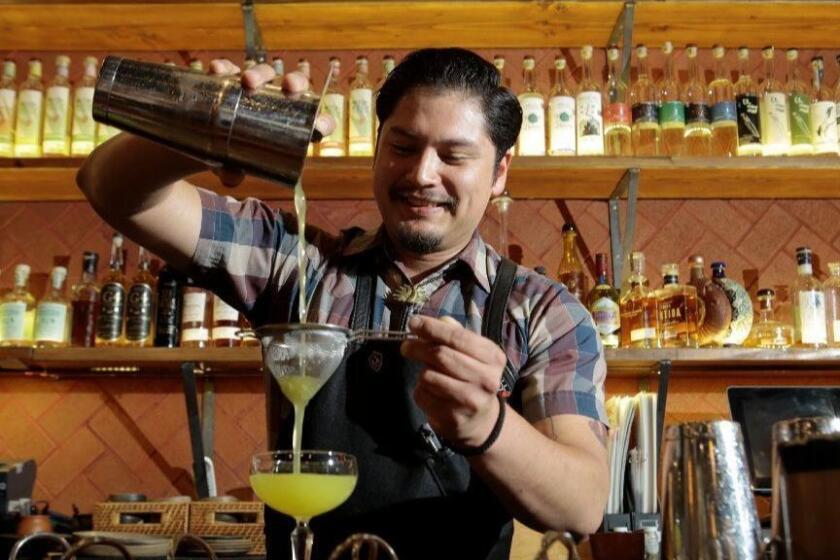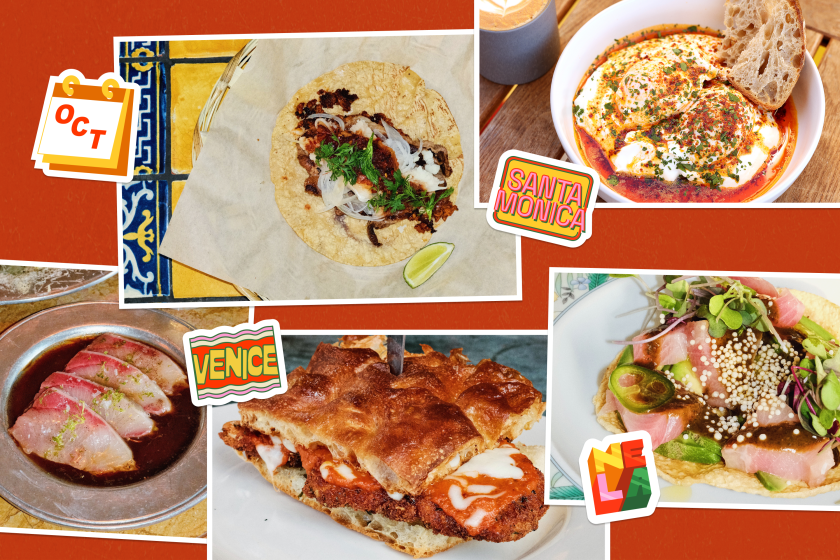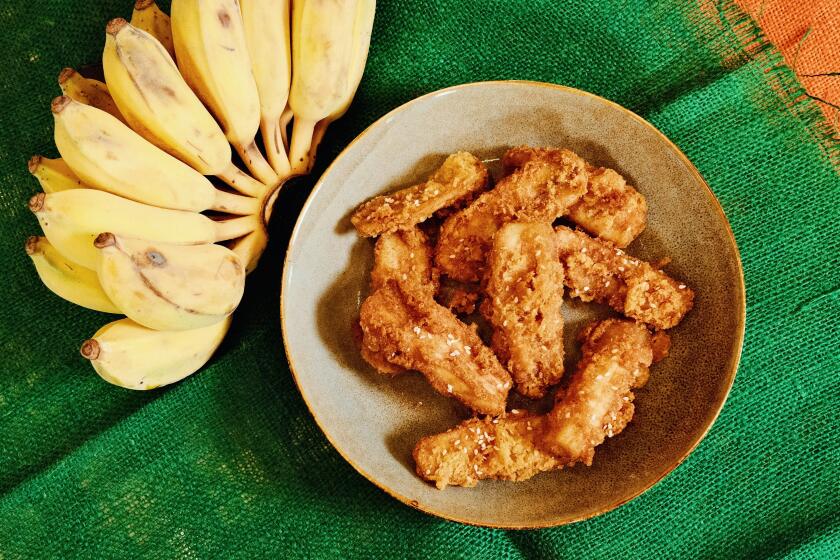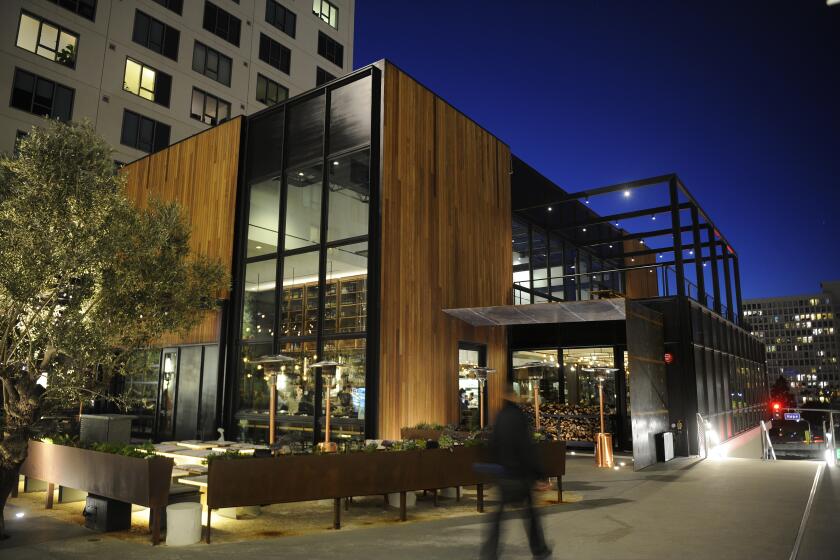Q&A: Mezcal For Dummies with Niki Nakazawa, the Oaxaca-based co-founder of Neta
Mezcal is all the rage, but how much do you really know about Mexico’s storied spirit? I asked Niki Nakazawa, the Oaxaca-based co-founder of the agave spirits company Neta (which just arrived in the United States, and is now available in Los Angeles), to give me Mezcal For Dummies but, like the spirit itself, her answers were more complicated than just “buy this, not that.”
What is mezcal?
For the record:
8:00 a.m. June 11, 2019An earlier version of this article included an editing error that mismatched the number of Mezcal-producing states in a sentence.
Traditionally, mezcal refers to all spirits that are distilled from agave. Technically, mezcal is a denomination of origin (DO) that includes ten states in Mexico, but the tradition of mezcal making extends beyond those ten states.
Eat your way across L.A.
Get our weekly Tasting Notes newsletter for reviews, news and more.
You may occasionally receive promotional content from the Los Angeles Times.
At Neta we can’t legally label our spirits “mezcal” because we decided not to work under the denomination of origin, so we label them “spirits distilled from agave.” Our bottles pass the exact same chemical analyses required for mezcal and are made from 100% agave, but we decided to opt out of the DO because of the elevated costs associated with certification for the small farmers and producers we work with.
What about tequila? If mezcal traditionally encompasses all the agave spirits, then what is the difference between tequila and mezcal?
What we call tequila now was originally called mezcal de Tequila. If we’re going to be very pure about what the meaning of mezcal is — a word that belongs to Mexico and encompasses all of the different spirits that are made with agave — then tequila is a type of mezcal.
If you want to be by the book about it, there was a denomination of origin of mezcal established in 1994 and a denomination of origin of tequila established in 1974 that defined what those terms mean, but again, they don’t relate to the traditions of Mexico. Under the DO, tequila is made with one type of agave, the Tequilana Weber, and associated with a certain geographical area. Mezcal is also associated with a certain geographical area, but it can be made from any agave.
The word mezcal is composed of two Nahuatl words: metl, which means maguey, and ixcalli, which refers to a conical, earthen oven where the agaves are cooked. And this second part, the cooking part, is what distinguishes mezcal from tequila. When tequila became industrialized they started using autoclaves (pressurized ovens) and different forms of extraction to get sugars from the agave without cooking them underground.
Does cooking the agave underground give mezcal an inherent smoky quality?
Smoke is a stylistic aspect of some mezcals. You can’t ferment raw agave so you have to transform it through cooking in order to have fermentable sugars, and that cooking process happens in these pre-Hispanic earthen ovens. When you’re building these ovens, you first build a fire, and then on top of that fire you’re piling up rocks or river stones that can retain heat. So there isn’t necessarily a lot of wood smoke that is coming through.
Depending on the type of wood that you use and how much you shave down your agave you might have more smoke permeating through the oven. A higher sugar content and more caramelization can also affect smokiness, but it’s really regional and to the taste of the community. Where I work in Miahuatlán smokiness is not the primary note.
Interesting. So what other factors determine the flavor of a mezcal?
Mezcal is a terroir-driven spirit. In the same way that a Pinot Noir from California, Oregon and Australia are all going to have their own taste depending on where it’s grown, how old the vines are and who made it, the various expressions of mezcal come from the plant, the land and the style.
When you compare it to other spirits, the primary material is what’s unique to mezcal. Depending on the species, agaves can take anywhere from five to thirty years to be ready for harvest. And then you have the unique cooking process and fermentation, which in traditional mezcal is a natural, open-air ferment. Plus, there are different styles of distillation — you could be distilling twice in copper pots or using clay. There are so many diverse methods of production and they all affect flavor.
This is a lot to unpack when you’re sitting at the bar trying to decide which mezcal to try. If you’re new to mezcal, how do you recommend approaching it?
If you’ve never tried mezcal then start with a flight. Ask the bartender if you can get small pours of three different mezcals just to start orienting what you like. For instance, you could try three different espadines (the most common type of agave used for mezcal) from three different parts of Oaxaca, or you could focus on three different agaves from the same town.
What about if you’re at the liquor store trying to decode the bottles? What should we be looking for when we read the labels?
The more information you have on the bottle in terms of production the more likely that it’s an artisanal or traditional production. You want to know what agave it’s made out of. You want to know where it’s coming from. If it’s from Oaxaca, what part of Oaxaca? Who made it? What is the lot size?
Can I put mezcal in a cocktail or should it always be sipped neat?
Neat. It’s not that mezcal cocktails aren’t delicious, but I think that it’s important to enjoy mezcal alone because of the tremendous amount of effort that goes into making it. It’s made from a plant that takes so long to grow. It’s pure expression of terroir, and you’re going to put sugar and lime in it? That doesn’t seem right.
Mezcal needs to be kept at a certain price point to be sustainable. If all mezcal goes the direction of inexpensive well mezcal or low-ABV espadin, then it puts a lot of ecological stress on Oaxaca and other producing regions to grow low-price-point, high-yielding agave.
Oaxaca is the most biodiverse state in Mexico when it comes to agave. We have twenty-three agaves that can be used for mezcal production in Oaxaca alone, but if everyone just wants to drink mezcal in a cocktail, then farmers are like, “OK, well I need to eat so I’m going to tear up my land and just grow rows of espadin, all these other agaves that take longer to grow are too complicated.”
You bring up price point, which I think is one of the biggest barriers to entry with traditional mezcal. Bottles start around $50 and can go up to $180. Why is it so expensive?
It’s easier for consumers to understand when you tell them the age of the plant. Fourteen years of taking care of a plant is expensive! And it takes a long time to make. The process between the cooking, the fermenting and the distilling can take three weeks from start to finish.
And then dealing with the logistics of exporting these small productions is very expensive. It requires a lot of hands-on attention -- you’re paying the producer way more than market value (more than well mezcals), and the ones who are doing it right are making small lots in very rural places so you’re driving back and forth a lot. Where I’m working in Miahuatlán the average lot size is 100 to 200 liters.
Why do you think mezcal has become so popular in the States?
I think there is just enough good mezcal on the market to make it interesting. It’s like why natural wine is so popular. There are finally enough wines that you can drink through where you can have a real dialogue.
There has been an effort made by Del Maguey and other brands to push education, and you have places like Mezcaloteca in Oaxaca, Pare de Sufrir in Guadalajara and Bósforo in Mexico City where people can taste and learn about mezcal.
At Madre in Torrance, Bryant Orozco hoists himself up on a stepladder to reach the top of four shelves lined with nearly 400 bottles of mezcal.
It’s only been in the last ten years, and a lot of it is related to simple historic acts. The villages where mezcal is being produced weren’t actually connected by proper roads until fairly recently, so there was an issue of accessibility, but the quality of the spirit has changed too. The reason why mezcal in Mexico was associated with moonshine and the drink of poor was because the spirit wasn’t as refined in some communities as it is today.
In Miahuatlán the mezcal was originally a single distillation and it was way more rustic, but once the denomination of origin was established in 1994 there were some resources that became available that promoted the use of copper stills and double distillations. Double distillation really changed the game. You end up with a much cleaner spirit.
How has the increasing popularity of mezcal in the US impacted the producers in Mexico?
The upside is that it has encouraged a younger generation to stick around and choose to make mezcal. We’re seeing a lot of reverse migration. You see young people who had been living in the States coming back to their village and realizing, “Oh wow, this could be something.”
You also see a lot more brands coming to Oaxaca. There are a lot more bartenders from the States who think they can come down and make a mezcal brand without understanding how complicated it is.
Big companies are coming in and buying up brands, and we don’t really know what the affect of that is going to be quite yet. In the central valleys we are seeing more industrialization on the agricultural side of things. But what’s interesting is that on the one hand you have this direction towards big productions of all fast-growing espadin, and on the other hand you have the influence on smaller communities who see the higher price point of varieties like tobala and tepeztate and have started to grow those species of agave in areas where they aren’t native. So it’s influenced both sides.
More to Read
Eat your way across L.A.
Get our weekly Tasting Notes newsletter for reviews, news and more.
You may occasionally receive promotional content from the Los Angeles Times.











